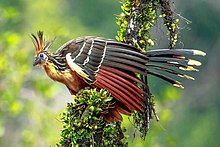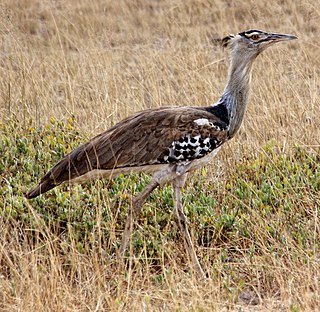
Otidae is a clade that includes the superorders Otidimorphae and Strisores. It was identified in 2014 by genome analysis. Earlier it was thought that Strisores was closely related to birds such as pigeons, flamingos, tropicbirds, and the sunbittern and kagu in the taxon Metaves, but subsequent work has provided evidence that Metaves is polyphyletic. Although analyses of genome data provided relatively high support for monophyly of Otidae, indicating that it occupies a basal branch of the clade Passerea, other analyses of large data matrices have not recovered a clade comprising Otidimorphae and Strisores, raising questions about the monophyly of Otidae.

The mousebirds are birds in the order Coliiformes. They are the sister group to the clade Eucavitaves, which includes the Leptosomiformes, Trogoniformes (trogons), Bucerotiformes, Piciformes and Coraciformes. This group is now confined to sub-Saharan Africa, and it is the only bird order confined entirely to that continent, with the possible exception of turacos which are considered by some as the distinct order Musophagiformes, and the cuckoo roller, which is the only member of the order Leptosomiformes, and which is found in Madagascar but not mainland Africa. Mousebirds had a wider range in the Paleogene, with a widespread distribution in Europe and North America during the Paleocene.

Glires is a clade consisting of rodents and lagomorphs. The hypothesis that these form a monophyletic group has been long debated based on morphological evidence. Two morphological studies, published in 2001 and 2003, strongly support the monophyly of Glires. In particular, the 2003 study reported the discovery of fossil material of basal members of Glires, particularly the genera Mimotona, Gomphos, Heomys, Matutinia, Rhombomylus, and Sinomylus. Their description, in 2005, helped to bridge the gap between more typical rodents and lagomorphs. Data published in 2001, based on nuclear DNA, supported Glires as a sister of Euarchonta to form Euarchontoglires, but some genetic data from both nuclear and mitochondrial DNA have been less supportive. A study, published in 2007, investigating retrotransposon presence/absence data unambiguously supports the Glires hypothesis. Studies published in 2011 and 2015 place Scandentia as a sister clade of the Glires, invalidating Euarchonta as a clade.

Neoaves is a clade that consists of all modern birds with the exception of Paleognathae and Galloanserae. Almost 95% of the roughly 10,000 known species of extant birds belong to the Neoaves.
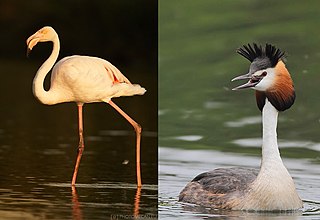
Mirandornithes is a clade that consists of flamingos and grebes. Many scholars use the term Phoenicopterimorphae for the superorder containing flamingoes and grebes.

Aequornithes, or core water birds, are defined as "the least inclusive clade containing Gaviidae and Phalacrocoracidae".
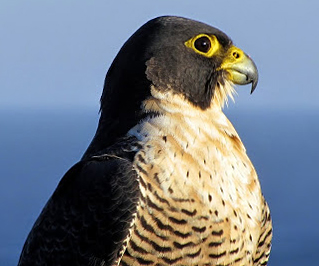
The order Falconiformes is represented by the extant family Falconidae and a handful of enigmatic Paleogene species. Traditionally, the other bird of prey families Cathartidae, Sagittariidae (secretarybird), Pandionidae (ospreys), Accipitridae (hawks) were classified in Falconiformes. A variety of comparative genome analysis published since 2008, however, found that falcons are part of a clade of birds called Australaves, which also includes seriemas, parrots and passerines. Within Australaves falcons are more closely related to the parrot-passerine clade (Psittacopasserae), which together they form the clade Eufalconimorphae. The hawks and vultures occupy a basal branch in the clade Afroaves in their own clade Accipitrimorphae, closer to owls and woodpeckers.

Eurypygiformes is an order formed by the kagus, comprising two species in the family Rhynochetidae endemic to New Caledonia, and the sunbittern from the tropical regions of the Americas. Its closest relatives appear to be the tropicbirds of the tropical Atlantic, Indian, and Pacific oceans.

Cariamiformes is an order of primarily flightless birds that has existed for over 60 million years. The group includes the family Cariamidae (seriemas) and the extinct families Phorusrhacidae, Bathornithidae, Idiornithidae and Ameghinornithidae. Though traditionally considered a suborder within Gruiformes, both morphological and genetic studies show that it belongs to a separate group of birds, Australaves, whose other living members are Falconidae, Psittaciformes and Passeriformes.

Strisores, sometimes called nightbirds, is a clade of birds that includes the living families and orders Caprimulgidae, Nyctibiidae (potoos), Steatornithidae (oilbirds), Podargidae (frogmouths), Apodiformes, as well as the Aegotheliformes (owlet-nightjars) whose distinctness was only recently realized. The Apodiformes and the Aegotheliformes form the Daedalornithes.
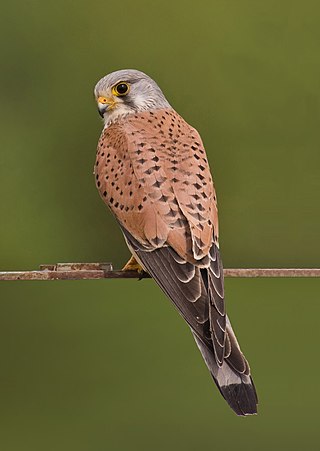
Australaves is a recently defined clade of birds, consisting of the Eufalconimorphae as well as the Cariamiformes. They appear to be the sister group of Afroaves. As in the case of Afroaves, the most basal clades have predatory extant members, suggesting this was the ancestral lifestyle; however, some researchers like Darren Naish are skeptical of this assessment, since some extinct representatives such as the herbivorous Strigogyps led other lifestyles. Basal parrots and falcons are at any rate vaguely crow-like and probably omnivorous.

Afroaves is a clade of birds, consisting of the kingfishers and kin (Coraciiformes), woodpeckers and kin (Piciformes), hornbills and kin (Bucerotiformes), trogons (Trogoniformes), cuckoo roller (Leptosomiformes), mousebirds (Coliiformes), owls (Strigiformes), raptors (Accipitriformes) and New World vultures (Cathartiformes). The most basal clades are predatory, suggesting the last common ancestor of Afroaves was also a predatory bird.

Telluraves is a recently defined clade of birds defined by their arboreality. Based on most recent genetic studies, the clade unites a variety of bird groups, including the australavians as well as the afroavians. They appear to be the sister group of the Ardeae.

Passerea is a clade of neoavian birds that was proposed by Jarvis et al. (2014). Their genomic analysis recovered two major clades within Neoaves, Passerea and Columbea, and concluded that both clades appear to have many ecologically driven convergent traits.

Eurypygimorphae or Phaethontimorphae is a clade of birds that contains the orders Phaethontiformes (tropicbirds) and Eurypygiformes recovered by genome analysis. The relationship was first identified in 2013 based on their nuclear genes. Historically these birds were placed at different parts of the tree, with tropicbirds in Pelecaniformes and the kagu and sunbittern in Gruiformes. Some genetic analyses have placed the eurypygimorph taxa in the controversial and obsolete clade Metaves, with uncertain placement within that group. More recent molecular studies support their grouping together in Eurypygimorphae, which is usually recovered as the sister taxon to Aequornithes within Ardeae.

Coraciimorphae is a clade of birds that contains the order Coliiformes (mousebirds) and the clade Cavitaves. The name however was coined in the 1990s by Sibley and Ahlquist based on their DNA-DNA hybridization studies conducted in the late 1970s and throughout the 1980s. However their Coraciimorphae only contains Trogoniformes and Coraciiformes.

Columbimorphae is a clade discovered by genome analysis that includes birds of the orders Columbiformes, Pterocliformes (sandgrouse), and Mesitornithiformes (mesites). Previous analyses had also recovered this grouping, although the exact relationships differed. Some studies indicated a sister relationship between sandgrouse and pigeons while other studies favored a sister grouping of mesites and sandgrouse instead.

Gruae is a clade of birds that contains the order Opisthocomiformes (hoatzin) and Gruimorphae identified in 2014 by genome analysis. Previous studies have placed the Hoatzin in different parts of the bird family tree; however, despite its unusual and primitive morphology, genetic studies have shown the hoatzin is not as primitive or as ancient as once thought, and that it could be a very derived bird that reverted to or retains some plesiomorphic traits.

Aequorlitornithes is a clade of waterbirds recovered in a comprehensive genomic systematic study using nearly 200 species in 2015. It contains the clades Charadriiformes, Mirandornithes and Phaethoquornithes. Previous studies have found different placement for the clades in the tree.

Vanescaves is a probable clade of strisorean birds that include the clades Steatornithiformes, Nyctibiiformes, Podargiformes (frogmouths), and Apodimorphae. Some molecular studies do support the grouping of these birds, others offer conflicting positions of the non-apodimorphaean strisoreans. In 2019 the authors Chen et al. performed a combined analysis using 2289 ultra-conserved elements [UCEs], 117 morphological characters from extant and fossil taxa found support in this clade. The authors then proposed to name this group, which its meaning is Latin for "vanish birds" in reference to the disparate nature of their geographic distribution, as well as to the poem "A Route of Evanescence" by the American poet Emily Dickinson which features a hummingbird as the main subject. In 2020 Chen & Field named the two major subclades of this group, with Sedentaves and Letornithes for their crown-groups.
